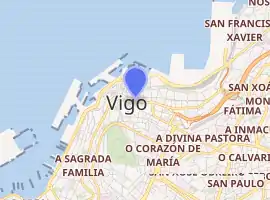Garcia Barbon Theatre
Garcia Barbon Theatre, officially Afundacion Vigo Theatre (Galician: Teatro Afundación Vigo), was built in the late nineteenth century in the centre of Vigo, a city in Northwestern Pontevedra, in Galicia, Spain. Sponsors included an enthusiastic group of locals who wanted to promote theatrical culture in the city. After years with a lot of economic problems, the theatre was opened on July 15 of 1900 as "Rosalía de Castro Theatre" and its first performance the opera Aida.
| Afundacion Vigo Theatre | |
|---|---|
Teatro Afundación Vigo | |
 | |

| |
| Former names | Rosalia de Castro Theatre |
| Alternative names | Garcia Barbon Theatre |
| General information | |
| Type | Theatre and library |
| Location | Vigo, Galicia, Spain |
| Coordinates | 42°14′16.45″N 8°43′24.2″W |
| Construction started | 1913 |
| Completed | 1927 |
| Opening | 1984 |
| Owner | Abanca |
| Management | Abanca |
| Design and construction | |
| Architect | Desiderio Pernas & Antonio Palacios |
| Website | |
| Official website | |
Years after was inaugurated and after a period of economic failure, the theater went bankrupt. It was a store for a short period of time before popular support and benefactor José García Barbon recovered the property and returned it to play representations.
On February 8, 1910, after the function in Carnival Tuesday, a fire completely charred the building, leaving the city without a theater again. Three years later, thanks to José García Barbon’s nieces who decided to continue the work of his uncle. The Galician architect Antonio Palacios was responsible for the construction of the new theatre building. Described as Neo-Baroque, a mainstream style in the beginning of the twentieth century, it was inspired by the Paris Opera of Charles Garnier and the Arriaga Theatre of Bilbao.
The new theatre was opened on April 23, 1927, under the name of Garcia Barbon theatre but it was not only a theatre, it was also auditorium and Casino, where people can see different kinds of show and becoming a meeting point.
During the seventies the building was bought by "Caja de Ahorros Municipal de Vigo" a regional Savings Bank from the same city. This entity spends more than 6 million of Euros in an important rehabilitation done by the architect Desiderio Pernas, expanding the theatre, creating a library in a new top floor and giving a new image to the building.
On March 22 of 1984 the building was reopened as the “Centro Cultural Caixanova” to be the bigger project conducted by the entity.
References
- http://hoxe.vigo.org/movemonos/h_barbon.php?lang=cas
- https://web.archive.org/web/20110524172838/http://www.udc.es/dep/com/ingles/barbon/barbonx.html
- https://web.archive.org/web/20100902040714/http://www.obrasocialcaixanova.com/es/centros/detalle/centro_cultural_caixanova
| Wikimedia Commons has media related to Teatro García Barbón. |